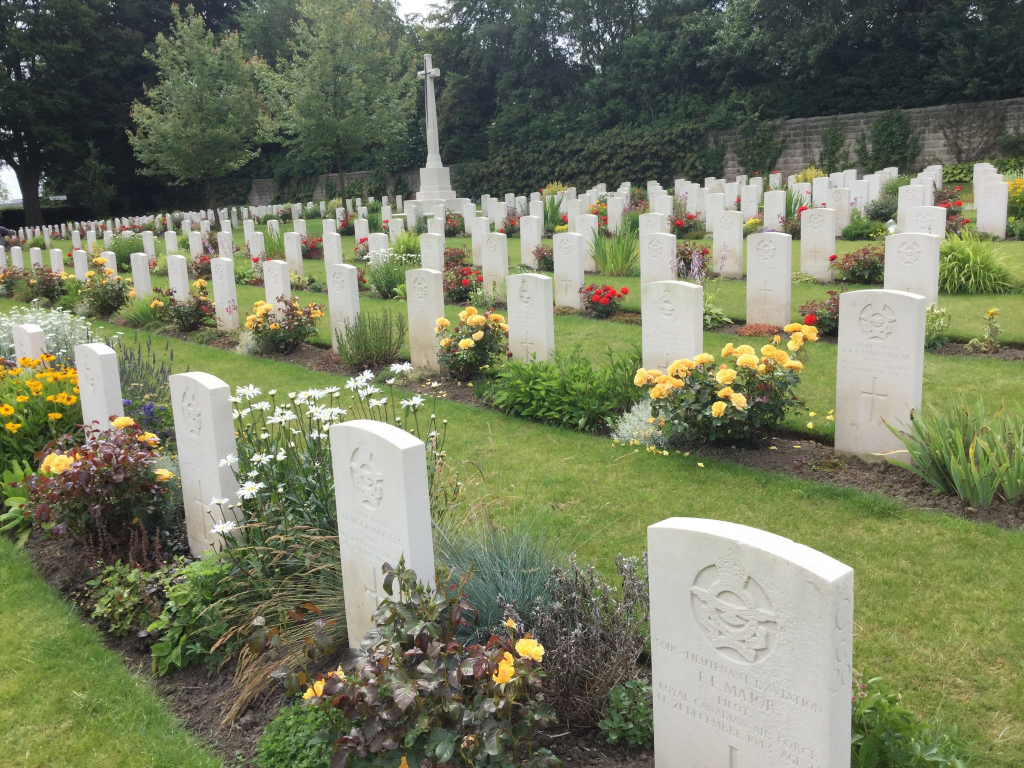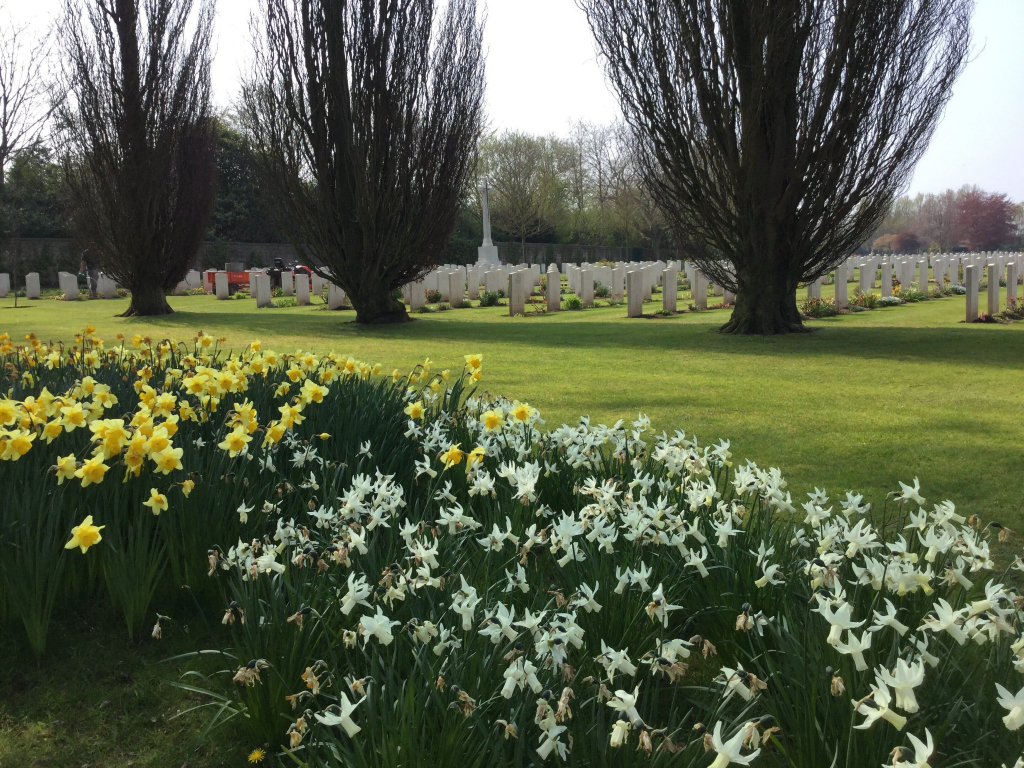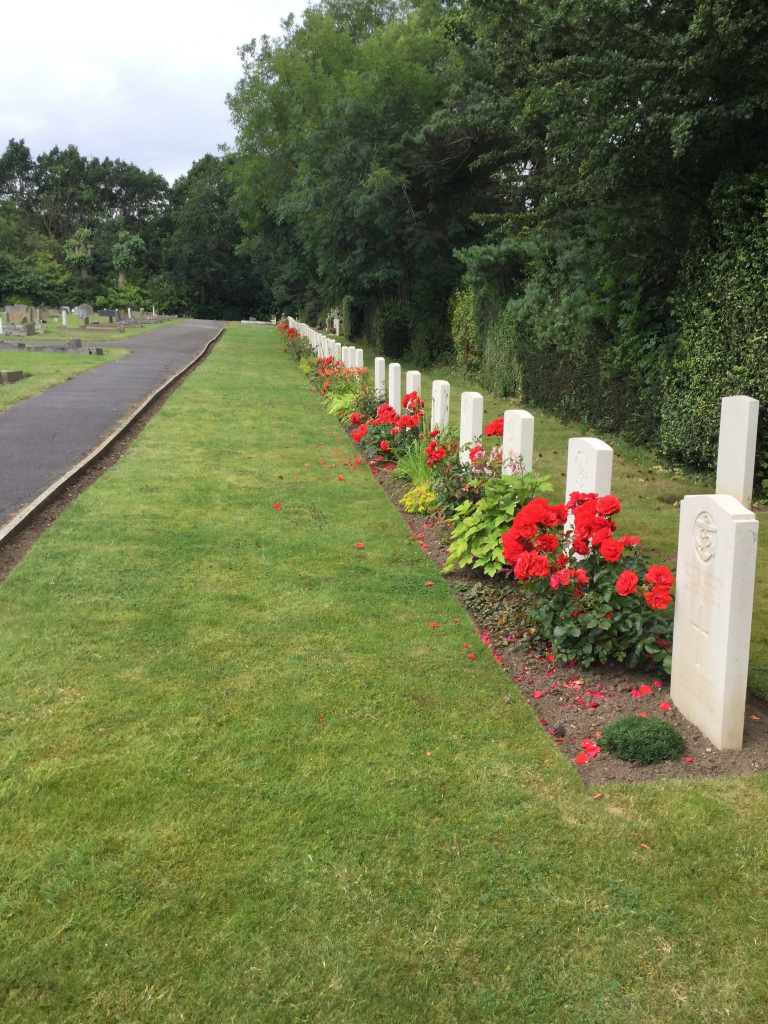Harrogate (Stonefall) Cemetery
- Country United Kingdom
- Total identified casualties 1013 Find these casualties
- Region Yorkshire
- Identified casualties from First & Second World War
- GPS Coordinates Latitude: 53.98543, Longitude: -1.49527
Our War Graves, Your History
Discover more about the history of Harrogate (Stonefall) Cemetery and plan a visit through our Our War Graves, Your History project.
Find out more
Memory Anchor tours are available for this site. If you already have the Memory Anchor app, open it an select this site from the list. To download the FREE app for Android or iOS, please use our app link below:
Cemetery Spotlight - Harrogate (Stonefall) Cemetery

Liam, Head Gardener Tim, and James: the team behind Harrogate (Stonefall) Cemetery
Tucked away on the outskirts of the historic spa town of Harrogate, just off the A661 on Forest Lane, lies Harrogate (Stonefall) Cemetery, a peaceful site of remembrance, and one of the most significant Commonwealth War Graves Commission cemeteries in northern England.
Although far removed from the frontlines of both World Wars, Harrogate played a vital role in Britain’s war effort. During the First World War, hundreds of local men and women volunteered to serve, with many returning to the town’s military and Red Cross hospitals to recover from their wounds.

Stonefall Cemetery, opened in 1914 by the local authority, became a final resting place for a small number of these casualties. Today, the graves of 16 service personnel from the First World War can be found here, along with seven commemorated by special memorials, scattered amongst the civilian plots as a quiet reminder of the war's reach.
But it is the Second World War that left the most visible legacy at Stonefall. The cemetery was chosen by the Air Ministry as a regional burial ground for the Royal Air Force, largely due to its central location and tranquil surroundings, considered a source of comfort for visiting, mourning families.
A plot was initially set aside near the crematorium in Sections 20E and 21E, but as the war intensified, demand grew rapidly. At the height of the conflict, burials averaged 30 to 40 a week, many of them airmen who died during operations or training accidents.
Today, the cemetery contains nearly 1,000 Commonwealth war graves, most from the Second World War, and remains a focal point for commemoration and reflection.
A standout feature of the cemetery is the avenue of Acers (maple trees) leading to the Cross of Sacrifice. These were a post-war gift from the Ontario Horticultural Association, a symbol of Canadian contribution and remembrance. In autumn, their vibrant colours provide a striking natural tribute to those who are buried here.

Harrogate Cemetery is one of 15 sites currently maintained by our team in the north, with typically just two days a week allocated to its upkeep. Yet, despite the limitations, the site is a testament to what can be achieved through care, planning, and sustainable practices.
The overall maintenance at Harrogate is shaped by the changing seasons. With the current warm summer, the team is focused on staying on top of headstone border work, prioritising weeding, deadheading, and weekly turf care. When conditions allow, they’ll move on to scarifying and aerating the turf, alongside hand-pulling rosette-type weeds to avoid the use of chemicals.
The team must remain highly flexible in their approach, as the weather is rarely on their side. This means having multiple plans in place each day and constantly reassessing to ensure their efforts are making the best possible impact.

Recent efforts have focused on enhancing biodiversity and sustainability with the addition of a wildflower area under the canopy of three huge beech trees. This has introduced a more naturalised area to Stonefall allowing wildlife to rummage through the tall grass, red campion, and oxeye daisy without being disturbed.
A wildflower area beneath three large beech trees now provides refuge for birds, bees, and small mammals. Bird boxes, hedgehog houses and two large bug hotels are dotted around the grounds, while a water retention unit allows the team to make use of collected rainwater on and off site. These initiatives not only support local ecosystems but also ensure that the cemetery remains a living, breathing landscape of remembrance.
In place of chemical pesticides, natural solutions are trialled, like introducing ladybird and lacewing larvae to manage aphid populations or using organic fertilisers such as ‘worm tea’ derived from vermicast. Spring and autumn bring composting and mulching, while summer efforts centre on weeding, deadheading, and weekly turf care.

By prioritising natural methods, the team not only protects the health of the plants and soil but also safeguards the long-term integrity of the site for future generations.
Location information
Harrogate (Stonefall) Cemetery is located south-east of Harrogate, on the fringe of the town, just off the A661 on Forest Lane.
Visiting information
ARRIVAL
All routes to the cemetery and parking area are signposted.
PARKING
There is a small parking area for 3 to 4 vehicles in front of the main entrance into the CWGC section of the cemetery, off Forest Lane.
There are multiple spaces to park within Stonefall Cemetery and Crematorium, through the main cemetery entrance on Wetherby Road (A661).
ACCESS LAYOUT AND MAIN ENTRANCE
The main entrance into the CWGC plot from Forest Lane is approximately 1.5 metres wide, through a double metal gate. The right-side gate is opened by turning the handle clockwise. The left side gate can be opened by lifting a vertical handle to allow both sections to be opened. There is a metal gate stop located at the centre of the entrance. The gate sections open inwards and is in line with the Stone of Remembrance in the centre of the plot.
Access is also possible along the boundary of the civil cemetery and the CWGC plot. There are grassed pathways on either side of a formal hedge in line with the Stone of Remembrance, at the midpoint of the western side of the plot.
There are two small two-step stairs on either side of the Stone of Remembrance, which can be bypassed on either side up sloped grass.
The CWGC plot is large, rectangular and slopes upwards from the northern end, where the shelter building is located, up to the Cross of Sacrifice at the southern end of the plot.
The shelter building is accessed via six steps from either side of the central opening arch. A decorative handrail is located on the exterior of the steps. The central arch has a two-leaf tall, 1.5 metre metal gate that opens into the building. There is a metal gate stop in the centre of the opening. There are multiple wooden benches located inside the shelter.
The Register Box is located inside the shelter building, in the left side wall.
There is a timber bench located along the perimeter of the plot, between the shelter and the entrance. There is another timber bench at the boundary of the civil cemetery, opposite the Stone of Remembrance, against the formal hedge.
ALTERNATIVE ACCESS
A second access route through the main gates of the cemetery. It is possible to drive a vehicle into the cemetery and park near to the chapel or in parking areas near the chapel.
The main route is tarmac and sloped, it leads directly to the municipal area, where there are scattered CWGC headstone and a small long formal plot of CWGC graves to the north of the chapel.
ADDITIONAL INFORMATION
The cemetery is permanently open when accessed from Forest Lane.
History information
Many airfields were established in Yorkshire during the Second World War, among them R.A.F. station at Harrogate, Linton-on-Ouse, Tockwith, Rufforth and Marston Moor. No. 6 (R.C.A.F.) Bomber Group, had their headquarters at Allerton Park near Knaresborough and all the stations controlled by this group were in the area north of Harrogate, the largest base having its headquarters at Linton-on-Ouse.
Nearly all of the 988 Second World War burials in Harrogate (Stonefall) Cemetery are of airmen, two-thirds of them Canadian. (1 of the burials is an unidentified R.A.F. airman), Many of these men died in the military wing of Harrogate General Hospital. During the early months of the war, a piece of land was set aside for service war burials in Sections 20E and 21E and in July 1943, the Air Forces Section was opened at the north-eastern corner of the cemetery for burials from airfields in Yorkshire and the north-eastern counties. A few of the war graves from this period are scattered elsewhere in the cemetery.
There are also 23 servicemen of the First World War buried or commemorated at Harrogate Stonefall. This total includes six casualties alternativley commemorated by special memorial because their graves in churchyards elsewhere* could no longer be maintained.
* Edlington (St Peter) New Churchyard ; Denholme Wesleyan Reform Chapelyard.




